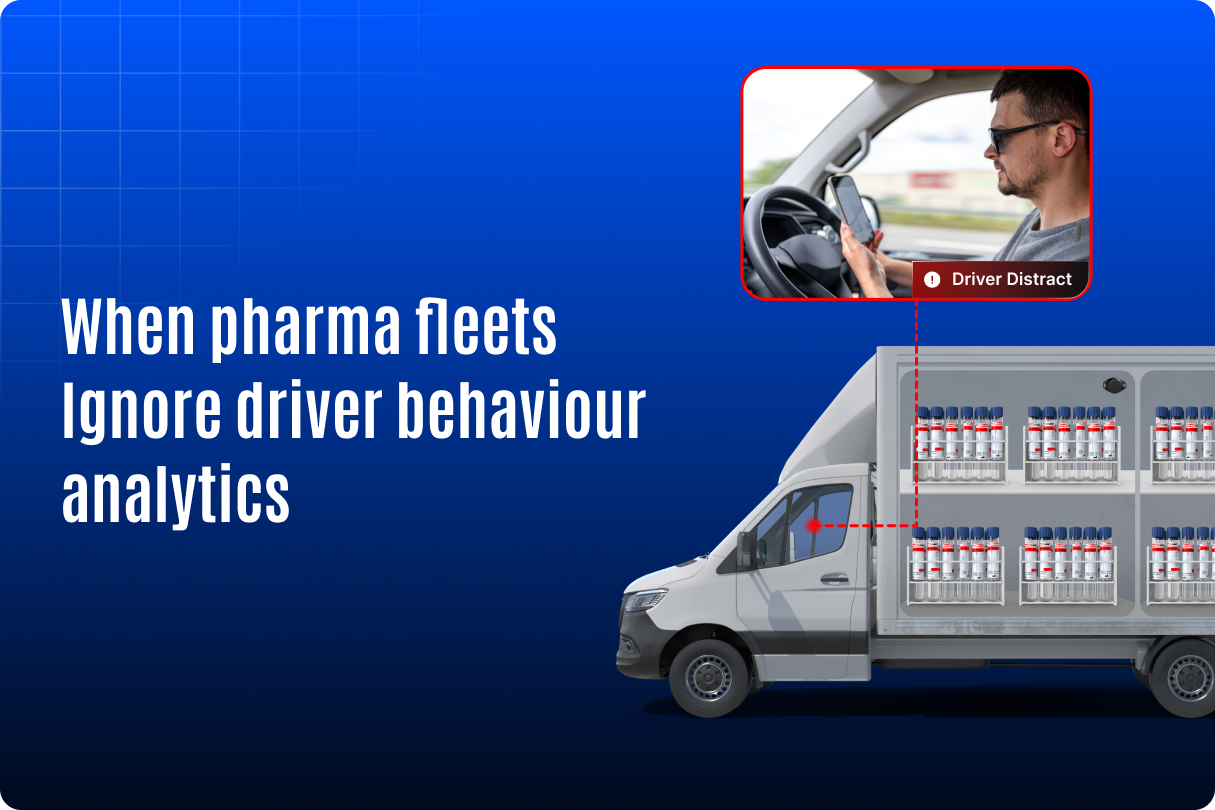What Pharmaceutical Fleet Managers Miss When They Ignore Driver Behaviour Analytics

Ever wondered why some pharma deliveries arrive in perfect condition while others get rejected even when both fleets use the same cold-chain tech?
It’s not always the equipment. Sometimes, it’s the person behind the wheel.
In pharmaceutical logistics, one harsh brake or long idle can spoil temperature-sensitive medicines worth thousands. Most fleets already track driver behaviour, but few realize how much it affects product quality and compliance.
That’s where driver behaviour analytics makes all the difference. It connects driving patterns with cold-chain performance helping fleets keep medicines safe, deliveries on time, and losses under control.
Why the cold chain depends on the driver
Even if the truck is fitted with the latest cold-chain technology, how the driver drives can still affect the temperature inside the container.
- Harsh braking or acceleration can cause sudden temperature changes inside the refrigerated unit.
- Long idling puts extra pressure on the cooling system and waste fuel.
- Rough driving or sharp turns can cause product vibration, affecting medicine quality.
Laws and standards such as GDP, WHO, and FDA guidelines require fleets to maintain strict temperature control during transport. They highlight the need to monitor temperature to ensure medicine quality and safety constantly. But technology alone cannot achieve this. It needs disciplined driving behaviour that supports real-time monitoring.
What Fleet Managers Often Miss in Cold Chain Operations
Many managers track driver behaviour but stop at getting alerts. They rarely use that information to improve fleet performance.
Here’s what often gets missed:
- Link between temperature change and driving habits — Mostly temperature changes happen because of harsh or careless driving.
- Excessive idling or taking a long route — This leads to excessive use of fuel and delays delivery.
- Uneven driving styles among drivers — Without analytics, training is based on assumptions, not facts.
When driver data is kept separate from other reports, managers cannot find the real cause of cold-chain issues. Careless driving spoils the goods, wastes fuel and causes audit problems.
Features that help pharma fleets improve driver behaviour and cold-chain stability
To maintain safe and compliant deliveries, pharma fleets need a system that connects driving behaviour with real-time cargo conditions. The right features help to detect issues early and prevent loss.
Key features to look for include:
- Driver scorecards and event monitoring – Track unsafe driving patterns like harsh braking, overspeeding and idling and evaluate overall driving performance.
- Temperature and sensor integration – Together with driving data and temperature logs, you can see how vehicle handling affects cargo safety.
- Trip replay and route insights – Replay trips to find where drivers made unsafe moves or deviated from the route.
- Driver coaching and training support – Use data-driven insight to train the drivers in a smooth way to handle temperature-sensitive cargo.
- Automated compliance reports – Generate ready-to-submit reports that connect temperature data with driving behaviour for faster audits.
These capabilities turn daily driving data into a complete view of cold-chain health helping managers move from monitoring to prevention.
Real results from smart analytics
Pharma companies that use driver behaviour analytics with cold-chain monitoring have seen great improvements:
- 25% fewer temperature deviations during trips.
- 15–20% lower rejection rate of medicine batches.
- 30% complete audits, since reports are linked and ready.
- Fleets reduce insurance claims through safer driving practices.
These results show how analysing driving data can help fleets save money, reduce waste, and improve delivery performance.
Why Ignoring Driver Analytics Can Be Costly
Some fleet operators see driver analytics as just an added feature, but in the pharmaceutical industry, it plays a key role in compliance and quality control.
Ignoring driver behaviour analytics causes serious problems
- It spoils or damages medicines during transport.
- It leads to failed audit reports and compliance penalties.
- It increases fuel waste and overall operational costs.
- Loss of trust from distributors and clients.
Every unanalysed data point is a missed opportunity to prevent problems and save costs.
Conclusion
In pharmaceutical transport, driving behaviour is not just about saving fuel or time; it’s about keeping medicines safe. Every action a driver takes affects the temperature and quality of the products being delivered.
When fleet managers use driver analytics, they get better control over trips. They can prevent spoilage, avoid delivery issues, and complete audits faster. By combining good driving habits with the right technology, pharma fleets can make sure every delivery stays safe, compliant, and reliable.
Because in medicine transport, it’s not only about reaching the destination it’s about delivering every dose in perfect condition.



